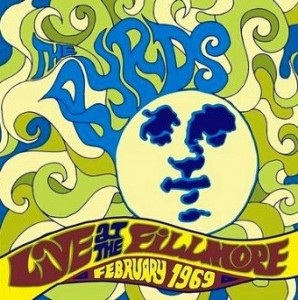THE BYRDS: LIVE AT THE FILLMORE (1969/2000)
1) Nashville West; 2) You're
Still On My Mind; 3) Pretty Boy Floyd; 4) Drug Store Truck Drivin' Man; 5)
Medley: Turn! Turn! Turn! / Mr. Tambourine Man / Eight Miles High; 6) Close Up
The Honky Tonks; 7) Buckaroo; 8) The Christian Life; 9) Time Between; 10) King
Apathy III; 11) Bad Night At The Whiskey; 12) This Wheel's On Fire; 13) Sing Me
Back Home; 14) So You Want To Be A Rock'n'Roll Star; 15) He Was A Friend Of
Mine; 16) Chimes Of Freedom.
In the case of The Byrds, the vault-emptying
ritual has largely focused on the Clarence White era, particularly when it
comes to live albums — the original Byrds were never appreciated much for their
live playing, not to mention that they fell apart just prior to the era of the
first quality recordings of live shows. However, the decision to open the
vaults with this particular recording, taped at two shows from the Fillmore
West on February 7-8, 1969, is still questionable. The new Byrds were just
getting their stuff together: Dr. Byrds
& Mr. Hyde had only been released one week before, and not only does
this mean that you are going to have to sit through quite a few mediocre songs
from that album, but it also means that everything else is happening in «test»
stage.
For instance, ʻEight Miles Highʼ, although
already a couple minutes longer than the original, has not yet been expanded to
the mammoth psychedelic heights of the Untitled
era — instead, it is included here as part of a frickin' medley, into which they have compressed three of their biggest
hits. The trick is a well-known cop-out: "we have no interest in playing
these songs any more, but out of a sense of loyalty, we're giving you a taste"
— and, honestly, they'd do better to leave out ʻTurn! Turn! Turn!ʼ and ʻMr.
Tambourine Manʼ of this altogether, because the harmonies on those songs just
flat out suck. Admittedly, the instrumental passages on ʻEight Miles Highʼ are
handled much better, with White already an accomplished sparring partner for
McGuinn.
Overall, the setlist predictably concentrates
on material from Dr. Byrds and from Sweetheart Of The Rodeo, with the
addition of a few extra country covers (Red Simpson's ʻClose Up The Honky Tonksʼ,
Merle Haggard's ʻSing Me Back Homeʼ, Buck Owens' ʻBuckarooʼ) and everything
else basically just played «for the old fans». This is in stark contrast with
the live material they'd soon record for Untitled,
which included only one pure country number and observed a better balance
between new and «classic» songs, so you have to be mentally prepared for the
fact that these Fillmore Byrds are shining knights of the Country Rock Order
through and through.
Arguably the one thing that is most typical and
representative of the album is Clarence White's manner of playing country
melodies — with a device called the Stringbender that he invented with Gene
Parsons, enabling him to play a regular electric Telecaster similarly to a
pedal steel guitar. This does bring a whole new twist to the idea of «country
rock», and gives all these instrumentals like ʻNashville Westʼ and ʻBuckarooʼ
a unique face — otherwise, we'd probably just ask "so why do we have to
listen to the Byrds doing this stuff, when it would make so much more sense to
just bring in the regular Nashville guard?" However, I would also insist
that true pedal steel gives a much prettier sound than a regular electric
guitar made to sound like a pedal steel; there's just something about this
imitation that throws me off (actually, a
lot of situations where instrument A is forced to sound closer to
instrument B throw me off, but maybe it's just me).
Still, it is a fact that White's guitar playing
is pretty much the only argument why you'd ever feel tempted to give this
another spin — in no other respect do these performances even come close to
matching the originals in clarity or emotional impact. Whenever he takes a
seriously focused solo, even on so-so material like ʻBad Night At The Whiskeyʼ,
the playing is clearly inspired (unfortunately, he does that on less than half
of the tracks), and even if that country style of his may seem a bit monotonous,
it also provides unity for all content — old classics, new originals, and cover
material. Just forget about The Byrds as one of America's (formerly) greatest
vocal harmony bands, and you'll be fine for a while.

Bow wow wow! where are the beastie boys?
ReplyDeleteI think I might have seen them on this tour. That is if they actually did any touring. They were the first band before Steppenwolf. They wore white suits with Bell bottoms and just stood still and played. Nothing stood out but everybody listened anyway. Steppenwolf came out and they were obviously drunk. The whole concert was not that great. The thing that impressed me was that bikers were every where. I had never seen a real chopper before. They were really primitive. The next day we went down to Padre Island and got sunburned riding the surf on inner tubes . Get yer motor running....
ReplyDelete